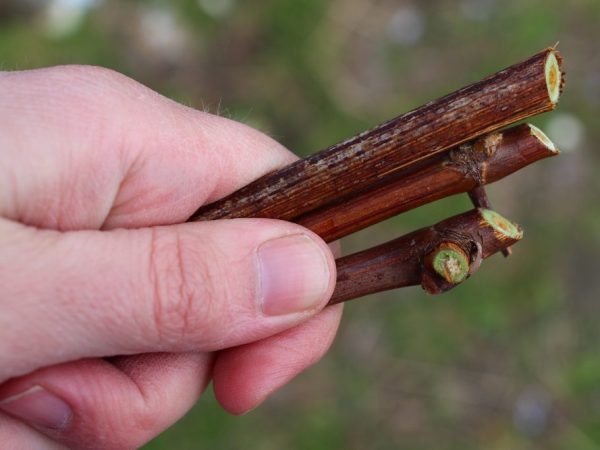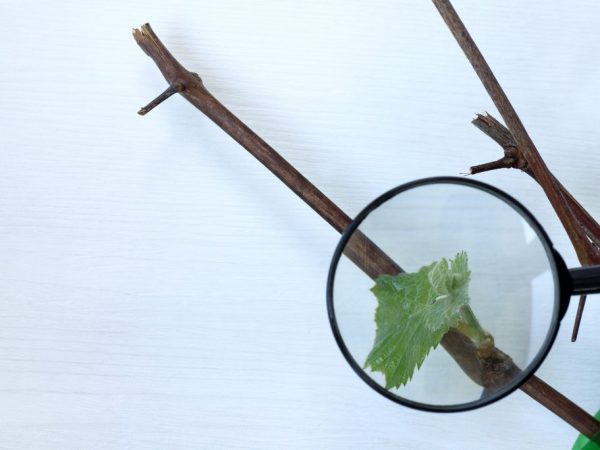Rules for propagating grapes by cuttings
In order not to buy seedlings, you should try to breed plants at home. Propagation of grapes by cuttings is one of the most effective and common methods. The planting material obtained by this method is highly resistant to disease.

Rules for propagating grapes by cuttings
Harvesting cuttings
You should start by cutting the shanks with a sharp garden pruner. Manipulations are performed in the fall after the leaves fall and before the onset of the first frost. At this time, all weak and damaged branches die off.
Choose a fruit vine that produces large clusters. Cuttings should be as straight and long as possible - they will give quality planting material.
Manipulations are performed so that no dents remain on the cut.
The cuttings should look healthy:
- light-colored bark;
- no stains, dry areas, damage.
Shoots are removed from the vine, the tip is cut off. Twigs with a length of 30 to 45 cm should turn out. A prerequisite is the presence of several developed buds. Immediately after cutting, the branches are placed in a solution of copper sulfate or in warm water for 1-2 days.
Storing cuttings
If the harvested material will be used in the spring, you should take care of providing it with appropriate conditions. The shanks of the same type are tied up and placed in a plastic bag separately from other types, tightly packed.
Storage areas:
- a refrigerator is a good way if there are few cuttings;
- basement - accommodates a large number of twigs, suitable for those gardeners who harvest them for the purpose of implementation;
- suburban area - branches are buried in the ground to a depth of more than 0.5 m.
The environment should be cool. At high temperatures, the kidneys will begin to swell.
Reproduction in the autumn
You need to start cultivating the culture before the onset of frost.
Seat selection

The plant needs sunlight
The area chosen for grapes should be well lit and warm, protected from the winds. The plant prefers loose soil with neutral or low acidity. Does not tolerate stagnant water, so swampy areas for cultivation are not suitable. It is better when there is some kind of structure nearby - a gazebo, a fence, so that the vine has the opportunity to branch. If it is not there, a support is built.
Cutting on a school
Dig trenches with a size of 0.3 * 0.3 with an interval of 0.4 m.A fertilizer solution is applied to the bottom of each. Plants are laid at an angle of 45 ° C with a north orientation. The distance between the seedlings is 15 cm. Then they are watered and hilled.
Landing in a permanent place
This method differs in that they do not dig trenches, but holes. The distance between the shanks is 2 m. In each recess, 2 vines are placed, since one may not take root.
Winter care
To cut grapes in the fall, you should take care of the shelter for the plant when it becomes winter outside. For this purpose, a greenhouse is erected with a height of more than 0.5 m. If this is not possible, the shanks are buried in earth, alternating with hay and spruce branches. The bulk layer should be at least 40 cm. A plastic wrap is pulled from above. With the arrival of heat, the shelter is removed.
Reproduction in the spring
For grape cuttings in spring, certain rules must be followed.
Preparing for landing
In winter, it is worth checking the shanks and selecting quality ones. To do this, around the end of January, they are removed from the storage location. To determine which branches are suitable for future manipulations, a cross-section is made on them. If it remains dry, the twig is discarded, as this indicates drying of the vine. These grape cuttings do not take root.
Signs of health of the shanks include:
- moisture that appears at the cut site;
- deep green color;
- lack of various inclusions.
2 days before germination, the selected branches are placed in a container with warm water, to which honey is sometimes added (1 tsp per 10 l). This will help bring them out of their dormant state. Next, the slices are updated in the middle of the node, right under the peephole, which is also removed. After that, the vine is treated with Kornevin, a stimulant for root growth. On its basis, according to the instructions, a solution is prepared. Chubuki are placed there.
Germination
There are several methods for rooting cuttings at home. Cultivation of planting material should take place with good lighting and timely, abundant watering. The lack of light is compensated for with the help of daytime lamps. Landing should be carried out in late February - early March.
In sawdust

You can germinate cuttings at home
For this method you will need:
- sharp knife;
- heating aquarium tool;
- sawdust from deciduous trees;
- large vessel.
The sawdust is pre-steamed to kill pathogenic bacteria. Cuttings are inserted into them. The substrate should be constantly moist, but not wet. To do this, it is moistened every 4-5 days.
A container with sawdust is placed in water with a temperature of 23 ° C (the temperature must be maintained). Germination is carried out in room conditions by placing the vessel on the windowsill. The glass will radiate cold to the top of the cuttings. In the absence of a heater, heating devices are used.
After 3 weeks, roots 1-1.5 cm long are formed.Rooting of grapes is ensured as follows:
- take a plastic bucket;
- a plastic water bottle is placed in the center;
- pour the substrate;
- in the middle between the walls of the bucket and bottle, shanks (10-15 cm) are deepened, the distance between which is kept about 3 cm;
- the temperature is maintained at the level of 25-26˚С using a heater.
In a plastic cup
A large vessel is chosen, 3 holes are drilled in the bottom. The soil is mixed with compost, placed on the bottom. Take another smaller glass, cut out its bottom, insert it into the first container. Cover with sand, thicken and moisturize. Plastic wrap is used to keep it warm. The shafts are stuck into the sand. They are waiting for the rooting of grape cuttings to occur.
In a plastic bottle
At the bottom of the container, drainage is laid at a low height. Top covered with compost, fertile soil or peat. The shank is placed in the ground so that its tip is flush with the bottle. Cover the top with a plastic glass, which is removed after the formation of young shoots.
In water
You can root grape cuttings in this way:
- take a jar or cut plastic bottle;
- put cotton wool in a layer of 2 cm, it will prevent the branches from drying out;
- water is poured to the same height, melt is perfect;
- add several tablets of activated carbon - this will prevent turbidity and mustiness of the liquid;
- place the shanks.
The vessel is placed in a well-lit place.Water is topped up regularly. Young shoots will appear first. Until roots are formed, the vine will consume the water from the jar. The rooting time depends on the plant variety and its quality. If the roots did not appear, but another shoot was formed, then the strongest one is removed so that it does not take on a lot of nutrition. Then you need to plant the roots in the ground, while there are no conditions for disembarkation on the street.

Rooting time depends on the grape variety
The soil is harvested in the fall. To do this, take the following components in equal parts:
- sod land;
- river or quarry sand;
- low-lying peat;
- unripe compost or humus;
- finely chopped green grass.
The mixture is moistened, placed in nylon bags for 1/3 of their volume and left. Excellent compost is obtained by the time of planting.
Kilchevanie
Rooting of lignified grape cuttings at home is also carried out using a kilchevator - a box in which there is an equipped heating. It is placed in a room where the temperature indicators are at the level of 0-10˚С. The shanks are stuck in.
Landing in open ground
Landing in a permanent place is made from March to June, depending on the climatic conditions of the region. The air must warm up to at least 2˚C. Plants are pre-tempered by taking them outside in the morning or afternoon.
Disembarkation process:
- dig a hole 0.5 m deep;
- drainage is laid on the bottom, humus on top is a source of nutrients for the culture;
- watered with warm water;
- from the container, along with a lump of earth, carefully remove the seedling so as not to damage the roots;
- fall asleep with soil;
- mulch with more humus and again bring warm water (2 buckets).
If, after planting, the weather does not please with spring warmth, the plant is insulated. For this, the earth around him is covered with plastic wrap, leaves and branches. The plant is also protected from direct sunlight for several weeks.
Growing grapes with green cuttings
Preparation of planting material for propagation of grapes using green stems:
- take shoots that remained after pinching;
- cut into two-bud cuttings - an oblique cut is made under the lower knot, from above - 2-3 cm above the knot;
- remove the lower leaves, leave the upper one, if it is large, cut off half;
- green branches are immediately placed in the water.
Then they make a landing. Plants are placed in a greenhouse, shaded in summer until they begin to grow. In the fall, the seedlings are looked after at home. In the spring, they are transplanted into a large container. Dates of disembarkation in open ground - mid-September. Grapes are planted in trenches.
Leaving after disembarkation
In order for the seedlings to take root in a new place and to please them with good development in the future, they perform the following manipulations:
- Remove weeds. The first 2-3 years after planting, the soil is loosened 3 times throughout the season - this contributes to the access of oxygen to the roots. The soil is mulched to retain moisture.
- Crop rotation is observed on the site - different grasses are sown.
- Plants are watered regularly and abundantly, according to weather conditions.
- They are periodically fed.
- With the development of several shoots, a stronger one is left, the rest are removed.
Conclusion
The cultivation of grapes involves different processes, the environment of which is its cultivation. Propagate the culture with easy green and lignified cuttings. Taking into account the rules of the process, gardeners achieve good results.
If the shanks are properly cared for, the culture will thrive. And over time, it will delight you with delicious fruits. In this way, the wild Vici grape is also bred, which is used to decorate the garden.


